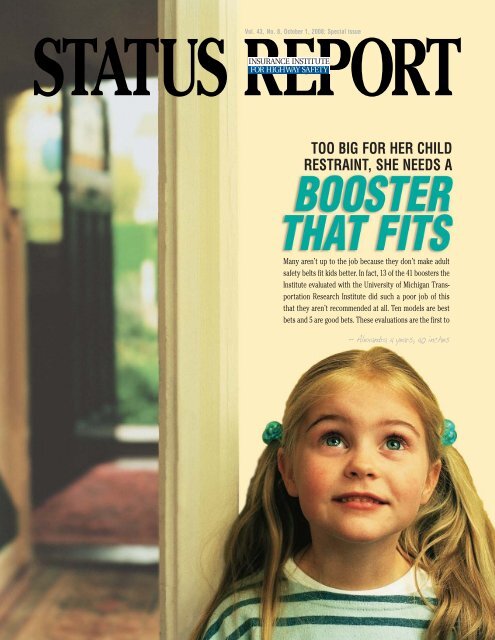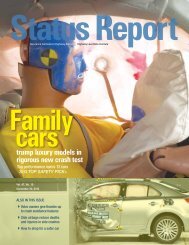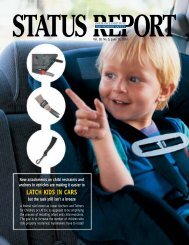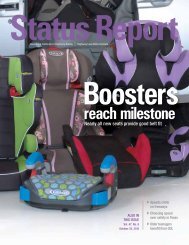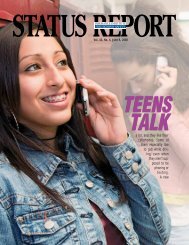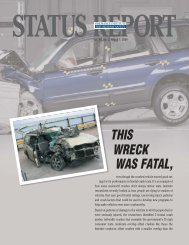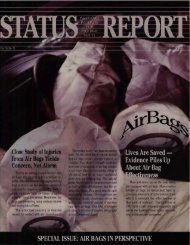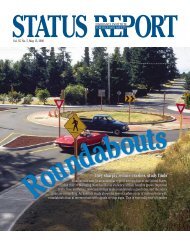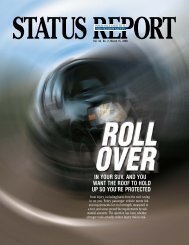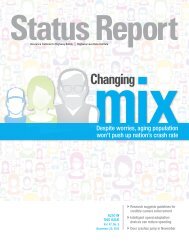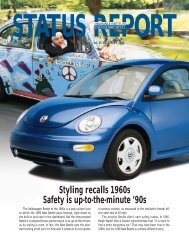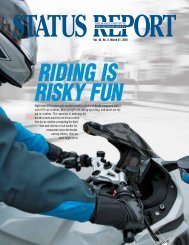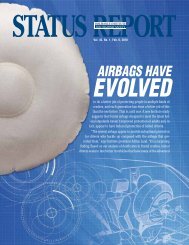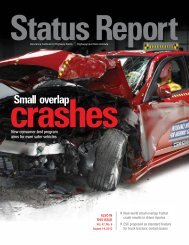Vol. 43, No. 8, October 1, 2008 - Insurance Institute for Highway Safety
Vol. 43, No. 8, October 1, 2008 - Insurance Institute for Highway Safety
Vol. 43, No. 8, October 1, 2008 - Insurance Institute for Highway Safety
Create successful ePaper yourself
Turn your PDF publications into a flip-book with our unique Google optimized e-Paper software.
<strong>Vol</strong>. <strong>43</strong>, <strong>No</strong>. 8, <strong>October</strong> 1, <strong>2008</strong>: Special issue<br />
TOO BIG FOR HER CHILD<br />
RESTRAINT, SHE NEEDS A<br />
Many aren’t up to the job because they don’t make adult<br />
safety belts fit kids better. In fact, 13 of the 41 boosters the<br />
<strong>Institute</strong> evaluated with the University of Michigan Transportation<br />
Research <strong>Institute</strong> did such a poor job of this<br />
that they aren’t recommended at all. Ten models are best<br />
bets and 5 are good bets. These evaluations are the first to<br />
— Alexandra 4 years, 40 inches
2 Status Report, <strong>Vol</strong>. <strong>43</strong>, <strong>No</strong>. 8, Oct. 1, <strong>2008</strong><br />
tell US consumers how well belt-positioning<br />
boosters improve belt fit <strong>for</strong> booster-age children<br />
in cars, minivans, and SUVs.<br />
“We evaluated the safety belt fit boosters<br />
provide, not crash protection,” says <strong>Institute</strong><br />
president Adrian Lund. “This is because unlike<br />
child restraints, boosters don’t restrain chil-<br />
PROPER BELT FIT<br />
Boosters elevate children so<br />
that safety belts designed <strong>for</strong><br />
adults will fit better. The lap<br />
belt should fit flat across<br />
a child’s upper thighs, not<br />
across the soft abdomen,<br />
which is more likely to be<br />
injured in a crash than bony<br />
structures like the pelvis.<br />
The shoulder belt should<br />
cross snugly over the middle<br />
of a child’s shoulder. Then it’s<br />
in position to provide effective<br />
protection in a crash. Plus it’s<br />
com<strong>for</strong>table to use, so a child<br />
won’t be as likely to move it<br />
behind the back or under an<br />
arm. See iihs.org/research/<br />
topics/child_restraints/<br />
default.html.<br />
dren in crashes. They simply position kids so<br />
lap and shoulder belts are in the right place to<br />
restrain them.” Good boosters route belts<br />
across a child’s bony parts, not soft parts like<br />
the abdomen, which is more vulnerable.<br />
Two booster types — backless and highback<br />
— were assessed under conditions representing<br />
a range of 2001-06 model vehicles.<br />
Some highbacks convert to backless, and<br />
some boosters, called combination seats, can<br />
be used as child restraints. Highback and backless<br />
modes were evaluated separately because<br />
each mode affects how belts fit. More importance<br />
was assigned to lap belt fit. All of the<br />
best-bet boosters locate this belt on the upper<br />
thighs. The main problem <strong>for</strong> the boosters<br />
that aren’t recommended is they leave<br />
the lap belt on the abdomen. Fit<br />
is important because<br />
a correctly positioned lap belt loads pelvic bones during a crash, not<br />
the abdomen. A good booster also positions the shoulder belt at<br />
midshoulder, keeping the webbing away from the neck so it won’t<br />
chafe and reducing the likelihood that kids will endanger themselves<br />
by putting the belt behind their back or under an arm.<br />
“We’d expect the 10 best bets to improve belt fit <strong>for</strong> children<br />
in almost any car, minivan, or SUV,” Lund says. “Likewise,<br />
it’s clear that kids in the 13 boosters<br />
we don’t recommend aren’t<br />
getting the full benefit of improved<br />
lap belt fit. These boosters<br />
may increase restraint use by<br />
making children more com<strong>for</strong>table,<br />
but they don’t position<br />
belts <strong>for</strong> optimal protection.”<br />
Boosters the <strong>Institute</strong> does<br />
not recommend are the highback<br />
Compass B505, Compass<br />
B510, Cosco/Dorel Traveler, and<br />
Evenflo Big Kid Confidence; backless<br />
<strong>Safety</strong> Angel Ride Ryte; combination<br />
Cosco/Dorel Alpha Omega,<br />
Cosco/Dorel (Eddie Bauer) Summit,<br />
Cosco Highback Booster, Dorel/<br />
<strong>Safety</strong> 1st (Eddie Bauer) Prospect,<br />
Evenflo Chase Com<strong>for</strong>t Touch,<br />
Evenflo Generations, Graco Car-<br />
Go Zephyr, and <strong>Safety</strong> 1st/<br />
Dorel Intera. At least 2 of<br />
these models have been discontinued, hopefully<br />
replaced by better designs. Booster makers<br />
sometimes reuse names and even model numbers<br />
<strong>for</strong> new seats, so manufacture dates and<br />
model numbers are important. Go to iihs.org<br />
<strong>for</strong> the full list of boosters in this evaluation.<br />
“Our data show it’s possible to design a<br />
booster with good lap and shoulder belt fit,”<br />
says Matt Reed, the study’s lead author<br />
and research associate professor at the<br />
University of Michigan Transportation Research<br />
<strong>Institute</strong>. “Boosters that can’t do<br />
that should be redesigned.” The 10 best-<br />
(continues on p.6)
Status Report, <strong>Vol</strong>. <strong>43</strong>, <strong>No</strong>. 8, Oct. 1, <strong>2008</strong> 3<br />
NEXT STEP AFTER<br />
CHILD RESTRAINTS<br />
When children outgrow child restraints, parents may<br />
wonder if booster seats are necessary. They are,<br />
because safety belts are designed to fit adults, not<br />
young children. For most kids, belts usually don’t fit<br />
properly until they’re 4 feet, 9 inches tall. Boosters<br />
do what their name implies — elevate children so<br />
3-point belts are positioned to provide effective<br />
restraint during a crash.<br />
About 350 children ages 4-7 die in crashes each<br />
year in the United States. An additional 50,000<br />
are injured. Because half of the fatally<br />
injured children in this age group ride unrestrained,<br />
the first step is to get them belted.<br />
Belt-positioning boosters can<br />
help by improving the fit, effectiveness,<br />
and com<strong>for</strong>t of<br />
adult belts.<br />
There’s convincing evidence that boosters, used with<br />
lap/shoulder belts, offer the safest way <strong>for</strong> kids to ride in<br />
vehicles once they outgrow child restraints, usually at age<br />
4. Using boosters lowers injury risk by 59 percent compared<br />
with belts alone, a 2003 study by the Center <strong>for</strong><br />
Injury Research and Prevention at the Children's Hospital<br />
of Philadelphia found. <strong>No</strong>ne of the 4-7 year-olds in boosters<br />
had any injuries to the abdomen, neck, spine, or back.<br />
Such injuries did occur among children using belts alone.<br />
A 2006 study by the same authors found that boosters<br />
reduce fatality risk among booster-age children by about<br />
28 percent compared with belts alone.<br />
Boosters don’t work like child restraints. Rear-facing<br />
restraints <strong>for</strong> infants and <strong>for</strong>ward-facing ones <strong>for</strong> toddlers<br />
and younger preschoolers are designed with built-in<br />
harnesses, sturdy structures, and foam padding to<br />
protect and restrain children in crashes.<br />
Boosters themselves don’t restrain kids.<br />
A vehicle’s safety belts do. Boosters position<br />
the belts so they’ll work best. Some manufacturers<br />
claim their boosters provide extra<br />
protection in certain crashes like side impacts. Because<br />
there’s no government or independent verification<br />
of these claims, parents are left to decide on their<br />
own if such features will help or are marketing gambits.<br />
BOOSTERS ELEVATE CHILDREN<br />
so 3-point belts are positioned<br />
<strong>for</strong> effective restraint in a crash.<br />
It’s possible to design a booster with<br />
good fit of both lap and shoulder belts.<br />
Boosters that can’t do it should<br />
be redesigned.
4 Status Report, <strong>Vol</strong>. <strong>43</strong>, <strong>No</strong>. 8, Oct. 1, <strong>2008</strong><br />
USE A BOOSTER,<br />
BUT WHICH ONE?<br />
The federal government and American Academy<br />
of Pediatrics recommend boosters <strong>for</strong> kids<br />
who’ve outgrown child restraints and are at<br />
least 4 years old and 40 pounds, until they’re 4<br />
feet, 9 inches tall. What kind to choose?<br />
Highback boosters have built-in guides to<br />
position shoulder belts as well as lap belts and<br />
offer some head support. Highbacks are especially<br />
recommended in vehicles without head<br />
restraints in back seats. Some highbacks, including<br />
many the <strong>Institute</strong> evaluated, can convert<br />
to backless boosters.<br />
Backless boosters have built-in lap belt<br />
guides but may need a plastic clip to properly<br />
position shoulder belts in many vehicles. These<br />
boosters are the least expensive and may be<br />
more popular with older children.<br />
Combination seats function as <strong>for</strong>wardfacing<br />
child restraints or boosters. An internal<br />
5-point harness restrains children when the<br />
seats are used as child restraints. In booster<br />
mode, the harness is removed and vehicle lap/<br />
shoulder belts restrain children.<br />
Three-in-1 seats, like combinations, adapt as<br />
kids grow. With a 5-point harness, this kind of<br />
restraint can be used in rear-facing mode <strong>for</strong> an<br />
infant and then as a <strong>for</strong>ward-facing child seat.<br />
Removing the harness turns a 3-in-1 into a<br />
booster <strong>for</strong> use with a lap/shoulder belt.<br />
BOOSTER<br />
ALTERNATIVE<br />
Manufacturers don’t recommend using boosters<br />
in the back seats of vehicles with lap belts only.<br />
Using boosters this way leaves a child’s upper<br />
body unrestrained. But if this is your only option,<br />
it’s better to use a booster with a lap belt than no<br />
booster at all. An alternative to a booster is a<br />
child restraint with a higher weight limit to<br />
accommodate children who weigh as much as<br />
80 pounds. Built-in 5-point harnesses, not adult<br />
lap/shoulder belts, provide the restraint. These<br />
seats are good options <strong>for</strong> all children and types<br />
of vehicles and can be used by parents who prefer<br />
to keep their children in harness restraints<br />
as long as possible (see iihs.org/research/topics/child_restraints/summary/html).<br />
BEST BETS<br />
Graco TurboBooster backless with clip<br />
Fisher-Price Safe Voyage backless with clip<br />
Combi Kobuk backless with clip<br />
Fisher-Price Safe Voyage<br />
Britax Parkway<br />
LaRoche Bros. Teddy Bear<br />
Safeguard Go backless with clip<br />
<strong>Vol</strong>vo booster cushion<br />
Recaro Young Style<br />
Britax Monarch<br />
GOOD BETS<br />
Graco TurboBooster<br />
<strong>Safety</strong> Angel Ride Ryte<br />
Recaro Young Sport<br />
Combi Kobuk<br />
<strong>Safety</strong> 1st/Dorel Apex 65<br />
<strong>Safety</strong> 1st/Dorel Intera backless<br />
Britax Monarch backless<br />
Combi Dakota backless with clip<br />
Magna Clek backless<br />
Dorel/<strong>Safety</strong> 1st (Eddie Bauer) Prospect backless<br />
Prorider CNS booster backless<br />
Cosco High Rise/Ambassador backless<br />
<strong>Vol</strong>vo booster cushion backless<br />
Evenflo Big Kid Confidence backless with clip<br />
Cosco/Dorel Protek backless<br />
Jane USA Indy<br />
Recaro Start<br />
Cosco/Dorel Protek<br />
NOT RECOMMENDED<br />
<strong>Safety</strong> Angel Ride Ryte backless<br />
Cosco/Dorel (Eddie Bauer) Summit<br />
Graco CarGo Zephyr<br />
Evenflo Big Kid Confidence<br />
Cosco/Dorel Traveler<br />
Compass B505<br />
Compass B510<br />
Evenflo Generations<br />
Dorel/<strong>Safety</strong> 1st (Eddie Bauer) Prospect<br />
Cosco Highback Booster<br />
Cosco/Dorel Alpha Omega<br />
Evenflo Chase Com<strong>for</strong>t Touch<br />
<strong>Safety</strong> 1st/Dorel Intera<br />
LAP BELT: RANGE OF FIT<br />
-10 0 10 20 30 40 50 60<br />
Belt on abdomen<br />
Belt flat on thighs<br />
NO MATTER HOW A<br />
IN THEIR CAR. TH<br />
THE TOP SEATS.<br />
RIDE RESTRAINE
BEST BETS<br />
Graco TurboBooster backless with clip<br />
Fisher-Price Safe Voyage backless with clip<br />
Combi Kobuk backless with clip<br />
Fisher-Price Safe Voyage<br />
Britax Parkway<br />
LaRoche Bros. Teddy Bear<br />
Safeguard Go backless with clip<br />
<strong>Vol</strong>vo booster cushion<br />
Recaro Young Style<br />
Britax Monarch<br />
GOOD BETS<br />
Graco TurboBooster<br />
<strong>Safety</strong> Angel Ride Ryte<br />
Recaro Young Sport<br />
Combi Kobuk<br />
<strong>Safety</strong> 1st/Dorel Apex 65<br />
<strong>Safety</strong> 1st/Dorel Intera backless<br />
Britax Monarch backless<br />
Combi Dakota backless with clip<br />
Magna Clek backless<br />
Dorel/<strong>Safety</strong> 1st (Eddie Bauer) Prospect backless<br />
Prorider CNS booster backless<br />
Cosco High Rise/Ambassador backless<br />
<strong>Vol</strong>vo booster cushion backless<br />
Evenflo Big Kid Confidence backless with clip<br />
Cosco/Dorel Protek backless<br />
Jane USA Indy<br />
Recaro Start<br />
Cosco/Dorel Protek<br />
NOT RECOMMENDED<br />
<strong>Safety</strong> Angel Ride Ryte backless<br />
Cosco/Dorel (Eddie Bauer) Summit<br />
Graco CarGo Zephyr<br />
Evenflo Big Kid Confidence<br />
Cosco/Dorel Traveler<br />
Compass B505<br />
Compass B510<br />
Evenflo Generations<br />
Dorel/<strong>Safety</strong> 1st (Eddie Bauer) Prospect<br />
Cosco Highback Booster<br />
Cosco/Dorel Alpha Omega<br />
Evenflo Chase Com<strong>for</strong>t Touch<br />
<strong>Safety</strong> 1st/Dorel Intera<br />
SHOULDER BELT: RANGE OF FIT<br />
70 80 90<br />
Belt too far <strong>for</strong>ward on thighs<br />
-60 -40 -20 0 20 40 60 80 100 120 140 160<br />
Belt too close to neck Belt at<br />
midshoulder<br />
Belt too far out on shoulder<br />
BOOSTER RATES, PARENTS STILL NEED TO SEE HOW IT FITS THEIR CHILD<br />
EY SHOULDN’T RUSH TO BUY A NEW BOOSTER IF THEIRS ISN’T AMONG<br />
CHECK HOW IT FITS, AND REMEMBER IT’S BETTER FOR CHILDREN TO<br />
D IN ANY BOOSTER THAN TO LET THEM RIDE UNBUCKLED.
6 Status Report, <strong>Vol</strong>. <strong>43</strong>, <strong>No</strong>. 8, Oct. 1, <strong>2008</strong><br />
(continued from p.2) bet boosters are the most<br />
likely to position not only lap belts but also<br />
shoulder portions correctly on many children in<br />
many vehicles. Best bets include 3 backless<br />
seats: Combi Kobuk, Fisher-Price Safe Voyage,<br />
and Graco TurboBooster. These may require<br />
plastic clips to correctly position shoulder<br />
belts. Six highbacks are best bets: Britax<br />
Monarch, Britax Parkway, Fisher-Price Safe<br />
Voyage, LaRoche Bros. Teddy Bear, Recaro<br />
Young Style, and <strong>Vol</strong>vo booster cushion.<br />
Another best bet is the combination seat<br />
Safeguard Go when it’s used as a backless<br />
booster. Combination seats convert to boosters<br />
by removing their built-in harnesses. At<br />
least 5 of the best-bet boosters have been discontinued<br />
but still are sold.<br />
The 5 good bets provide acceptable belt fit<br />
in almost as many vehicle belt configurations.<br />
They are highbacks Combi Kobuk, Graco<br />
TurboBooster, and <strong>Safety</strong> Angel Ride Ryte, and<br />
combinations Recaro Young Sport and <strong>Safety</strong><br />
1st/Dorel Apex 65, when used as highbacks.<br />
“Parents don’t have to spend a lot of money<br />
<strong>for</strong> a booster that provides optimal fit,” Lund<br />
points out. The Graco TurboBooster, <strong>for</strong> example,<br />
isn’t the priciest. The highback version converts<br />
to a backless booster retailing <strong>for</strong> about<br />
$50, and the backless-only seat is about $20.<br />
Child safety seat laws in <strong>43</strong> states and the<br />
District of Columbia include booster seat provisions,<br />
but until now there has been little<br />
in<strong>for</strong>mation on how to pick one that provides<br />
proper belt fit. The government’s dynamic<br />
tests don’t measure what a booster is meant<br />
to do, which is to improve belt fit (see Status<br />
Report, Feb. 8, 2003; on the web at iihs.org).<br />
Congress in 2002 told the National <strong>Highway</strong><br />
Traffic <strong>Safety</strong> Administration to evaluate a belt<br />
fit test, but the agency decided to <strong>for</strong>go testing.<br />
Instead, it only rates boosters by how easy they<br />
are to use (see Status Report, Sept. 28, 2005; on<br />
the web at iihs.org). Manufacturers crash test<br />
boosters, but these simulated tests don’t tell<br />
parents how boosters will fit kids in their cars.<br />
How they’re evaluated: The booster evaluations<br />
(see pp.4-5) begin with lap belt fit.<br />
Researchers positioned a Hybrid III crash test<br />
dummy representing a 6 year-old, the average<br />
size of a booster-age child, in a booster in a<br />
second-row seat from a car. They assessed<br />
lap/shoulder belt fit under 7 conditions spanning<br />
a range of belt positions in 31 vehicles.<br />
Backless boosters generally provide better<br />
lap belt fit. Only 1 of the 15 backless boosters<br />
evaluated, the Graco TurboBooster used<br />
with a belt-positioning clip, provides optimal<br />
fit <strong>for</strong> both the lap and shoulder belts across<br />
all the belt configurations. On other backless<br />
boosters, the shoulder belt often falls too<br />
close to the neck or too far off the shoulder.<br />
When researchers evaluated the TurboBooster,<br />
they obtained the best shoulder belt fit when<br />
they used the clip the manufacturer provides<br />
<strong>for</strong> routing. Lund says parents with children in<br />
backless boosters should use the clips if<br />
needed to get good shoulder belt fit.<br />
Because of built-in guides, highbacks generally<br />
do a better job of positioning shoulder<br />
belts in all vehicle configurations. However, 12<br />
of the 26 evaluated fail to correctly position lap<br />
belts. Good boosters have belt-routing features<br />
that hold lap belts down and <strong>for</strong>ward.<br />
Combination seats and 3-in-1s: Six of the<br />
12 highbacks in the not-recommended group<br />
are combination seats that can be used as<br />
<strong>for</strong>ward-facing child restraints with 5-point harnesses,<br />
and 2 highbacks, the Cosco/Dorel Alpha<br />
Omega and <strong>Safety</strong> 1st/Dorel Intera, are 3-in-1<br />
seats that can be used rear-facing <strong>for</strong> infants.<br />
The Intera also converts to a backless booster.<br />
The Safeguard Go, which converts to a backless<br />
booster but not a highback, is the only combination<br />
seat that’s a best bet.<br />
“Combination and 3-in-1 seats are marketed<br />
as the last child seat parents need to buy,”<br />
Lund says, “but most of these seats aren’t the<br />
best choice as boosters. Parents need to be<br />
careful. These seats should be fine when<br />
their harnesses restrain younger children,<br />
but many of these designs compromise the<br />
ability to provide children with good belt<br />
fit as booster seats.”<br />
Child, booster, vehicle affect belt fit:<br />
The evaluations reflect the fit of a lap/<br />
shoulder belt <strong>for</strong> an average size 6 yearold<br />
in many belt configurations. Some<br />
boosters might fit bigger or smaller children<br />
better in vehicles with different belt<br />
setups. And unlike dummies, kids fidget<br />
and slouch in their seats, so the realworld<br />
fit boosters provide will vary.<br />
“<strong>No</strong> matter how a booster did in our<br />
evaluations, parents still need to see<br />
how it fits their child in their car,” Lund<br />
advises. He urges them “not to rush to<br />
buy a new booster if theirs isn’t among the top<br />
seats. Check how it fits and remember, it’s better<br />
<strong>for</strong> kids to ride restrained in any booster<br />
than to let them ride unbuckled.”<br />
Since boosters frequently change, several<br />
newer ones weren’t evaluated. The <strong>Institute</strong><br />
plans to continue these assessments.<br />
For a copy of “Evaluation of the static belt<br />
fit provided by belt-positioning booster seats”<br />
by M. Reed et al., write: Publications, <strong>Insurance</strong><br />
<strong>Institute</strong> <strong>for</strong> <strong>Highway</strong> <strong>Safety</strong>, 1005<br />
N. Glebe Rd., Arlington, VA<br />
22201, or email publications@<br />
iihs.org.
Status Report, <strong>Vol</strong>. <strong>43</strong>, <strong>No</strong>. 8, Oct. 1, <strong>2008</strong> 7<br />
NOT READY FOR<br />
ADULT SAFETY<br />
BELTS ALONE<br />
Using a safety belt greatly reduces the risk of<br />
injury to children in crashes, but belts often<br />
aren’t as effective as they could be <strong>for</strong> young<br />
children who have outgrown child restraints.<br />
These kids need booster seats to elevate them<br />
so lap and shoulder belts are properly positioned.<br />
Yet lots of 4-7 year-olds aren’t riding<br />
in boosters. Last year, 35 percent of<br />
children in this age group<br />
rode in adult belts compared<br />
with 37 percent<br />
in boosters and 13<br />
percent in child restraints.<br />
This is<br />
about the same percentage<br />
in boosters<br />
as in 2006.<br />
These are the<br />
findings of the<br />
National Survey<br />
of the Use<br />
of Booster Seats,<br />
conducted by the<br />
National <strong>Highway</strong><br />
Traffic <strong>Safety</strong> Administration (see www-nrd.nhtsa.dot.gov/pubs/810895.pdf). This survey also<br />
found that 15 percent of 4-7 year-olds were unrestrained. Twenty-five percent of 6 and 7 year-olds<br />
were in boosters during 2007, while 55 percent used safety belts, and 16 percent weren’t restrained<br />
at all. A new report on trends in child safety seat use is just out from the Children’s Hospital of<br />
Philadelphia (see www.chop.edu/carseat).<br />
The problem of premature graduation into the next level of restraint isn’t confined to boosterage<br />
children. Some infants are moved too soon out of their rear-facing restraints, and some toddlers<br />
are moved out of front-facing child seats be<strong>for</strong>e they’re big enough <strong>for</strong> boosters. The survey<br />
notes that 21 percent of children weighing 20-40 pounds rode in boosters in 2007, even though<br />
most child restraints can accommodate kids heavier than 40 pounds. Some of these children were<br />
as young as 1 year. Ten percent of children in this weight group were restrained by belts alone.<br />
Some boosters are designed <strong>for</strong> children weighing as little as 30 pounds. However, this doesn’t<br />
mean a child this small automatically should move into a booster. Some<br />
child restraints are made <strong>for</strong> kids weighing 65 and even 80 pounds.<br />
There also are boosters <strong>for</strong> kids up to 100 pounds.<br />
“A <strong>for</strong>ward-facing child restraint with a 5-point harness<br />
generally offers a better fit and more protection <strong>for</strong><br />
children at the younger and smaller end of the boosterage<br />
group,” says Anne McCartt, <strong>Institute</strong> senior vice<br />
president <strong>for</strong> research. “Some parents may rush to<br />
trade up to the next level because their children<br />
resist riding in restraints they consider babyish.<br />
The kids would prefer a more grown-up booster<br />
or even an adult safety belt, but they’ll be safer<br />
if parents wait to move them.”<br />
All children 12 and younger should ride in<br />
back seats. Infants should stay in rear-facing<br />
restraints until they’re at least 1 year old or weigh<br />
20 pounds. Some newer models can accommodate<br />
babies up to 30 pounds, so parents can keep using<br />
rear-facing restraints even after the first birthday. Then<br />
children graduate to <strong>for</strong>ward-facing seats until they’re<br />
about 4 years old and weigh 40 pounds. Only then does a<br />
booster become an appropriate option.<br />
Children should ride in boosters until they’re 4 feet, 9<br />
inches tall, usually around age 8. They need to be big<br />
enough to sit firmly against the seatback, with knees<br />
bent at the edge of the cushion. The lap belt should<br />
cross the upper thighs, and the shoulder belt<br />
should be on the middle of the shoulder.<br />
CHILDREN OF ALL AGES,<br />
from infants to grade<br />
schoolers, tend to move<br />
to the next step of restraint<br />
sooner than they need to.<br />
They’d be safer if parents<br />
wait to make the switch.
NON-PROFIT ORG.<br />
U.S. POSTAGE<br />
PAID<br />
PERMIT NO. 252<br />
ARLINGTON, VA<br />
1005 N. Glebe Rd., Arlington, VA 22201<br />
Phone 703/247-1500 Fax 247-1588<br />
Internet: www.iihs.org<br />
<strong>Vol</strong>. <strong>43</strong>, <strong>No</strong>. 8, Oct. 1, <strong>2008</strong><br />
This special Status Report focuses on booster<br />
seats. Recent special issues have included:<br />
Speed ................................................<strong>43</strong>:1 (<strong>2008</strong>)<br />
Motorcycles .....................................42:9 (2007)<br />
Convertibles ....................................42:6 (2007)<br />
Bumper per<strong>for</strong>mance .....................42:2 (2007)<br />
Frontal test ratings .........................41:3 (2006)<br />
Crash incompatibility ....................40:5 (2005)<br />
Alcohol .............................................40:4 (2005)<br />
Driver death rates ..........................40:3 (2005)<br />
Rear crash protection ....................39:10 (2004)<br />
Side impact tests ............................39:5 (2004)<br />
Speeding ........................................38:10 (2003)<br />
Side impact tests ............................38:7 (2003)<br />
SHE<br />
NEEDS A<br />
BOOST<br />
Contents may be republished with attribution.<br />
This publication is printed on recycled paper.<br />
The <strong>Insurance</strong> <strong>Institute</strong> <strong>for</strong> <strong>Highway</strong> <strong>Safety</strong> is a<br />
nonprofit scientific and educational organization<br />
dedicated to reducing deaths, injuries, and property<br />
damage from crashes on the nation’s highways.<br />
The <strong>Institute</strong> is wholly supported by auto insurers:<br />
21st Century <strong>Insurance</strong><br />
AAA Mid-Atlantic <strong>Insurance</strong> Group<br />
Affirmative <strong>Insurance</strong><br />
Agency <strong>Insurance</strong> Company<br />
AIG Agency Auto<br />
AIG Direct<br />
Alfa <strong>Insurance</strong><br />
Alfa Alliance <strong>Insurance</strong> Corporation<br />
Allstate <strong>Insurance</strong> Group<br />
American Family Mutual <strong>Insurance</strong><br />
American National Property and Casualty<br />
Ameriprise Auto & Home<br />
Amerisure <strong>Insurance</strong><br />
Amica Mutual <strong>Insurance</strong> Company<br />
Auto Club Group<br />
Auto Club South <strong>Insurance</strong> Company<br />
Bituminous <strong>Insurance</strong> Companies<br />
Bristol West <strong>Insurance</strong><br />
Brotherhood Mutual<br />
Cali<strong>for</strong>nia State Automobile Association<br />
Capital <strong>Insurance</strong> Group<br />
Chubb Group of <strong>Insurance</strong> Companies<br />
Concord Group <strong>Insurance</strong> Companies<br />
Cotton States <strong>Insurance</strong><br />
COUNTRY Financial<br />
Countrywide <strong>Insurance</strong> Group<br />
Erie <strong>Insurance</strong> Group<br />
Esurance<br />
Farm Bureau Financial Services<br />
Farm Bureau Mutual <strong>Insurance</strong> Company of Idaho<br />
Farmers <strong>Insurance</strong> Group of Companies<br />
Farmers Mutual of Nebraska<br />
First Acceptance Corporation<br />
Florida Farm Bureau <strong>Insurance</strong> Companies<br />
Frankenmuth <strong>Insurance</strong><br />
The GEICO Group<br />
Gainsco<br />
General Casualty <strong>Insurance</strong> Companies<br />
Georgia Farm Bureau <strong>Insurance</strong><br />
GMAC <strong>Insurance</strong><br />
Grange <strong>Insurance</strong><br />
The Hart<strong>for</strong>d<br />
Hanover <strong>Insurance</strong> Group<br />
High Point <strong>Insurance</strong> Group<br />
Homeowners of America<br />
ICW Group<br />
Indiana Farm Bureau <strong>Insurance</strong><br />
Kemper, a Unitrin Business<br />
Kentucky Farm Bureau <strong>Insurance</strong><br />
Liberty Mutual<br />
The Main Street America Group<br />
Markel Corporation<br />
Mercury <strong>Insurance</strong> Group<br />
MetLife Auto & Home<br />
Michigan <strong>Insurance</strong> Company<br />
MiddleOak<br />
MMG <strong>Insurance</strong><br />
Mutual of Enumclaw <strong>Insurance</strong> Company<br />
Nationwide <strong>Insurance</strong><br />
N.C. Farm Bureau Mutual <strong>Insurance</strong> Company<br />
<strong>No</strong>dak Mutual <strong>Insurance</strong><br />
<strong>No</strong>rfolk & Dedham Group<br />
Ohio Casualty Group<br />
Oklahoma Farm Bureau Mutual <strong>Insurance</strong> Company<br />
Oregon Mutual <strong>Insurance</strong><br />
Palisades <strong>Insurance</strong><br />
Pekin <strong>Insurance</strong><br />
PEMCO <strong>Insurance</strong><br />
The Progressive Corporation<br />
Response <strong>Insurance</strong><br />
Rockingham Group<br />
Safeco <strong>Insurance</strong><br />
Samsung Fire & Marine <strong>Insurance</strong> Company<br />
S.C. Farm Bureau Mutual <strong>Insurance</strong> Company<br />
SECURA <strong>Insurance</strong><br />
Shelter <strong>Insurance</strong><br />
Sompo Japan <strong>Insurance</strong> Company of America<br />
State Auto <strong>Insurance</strong> Companies<br />
State Farm<br />
Tennessee Farmers Mutual <strong>Insurance</strong> Company<br />
Tokio Marine Nichido<br />
The Travelers Companies<br />
Unitrin<br />
USAA<br />
Virginia Farm Bureau Mutual <strong>Insurance</strong><br />
West Bend Mutual <strong>Insurance</strong> Company<br />
Zurich <strong>No</strong>rth America<br />
FUNDING ASSOCIATIONS<br />
American <strong>Insurance</strong> Association<br />
National Association of Mutual <strong>Insurance</strong> Companies<br />
Property Casualty Insurers Association of America


